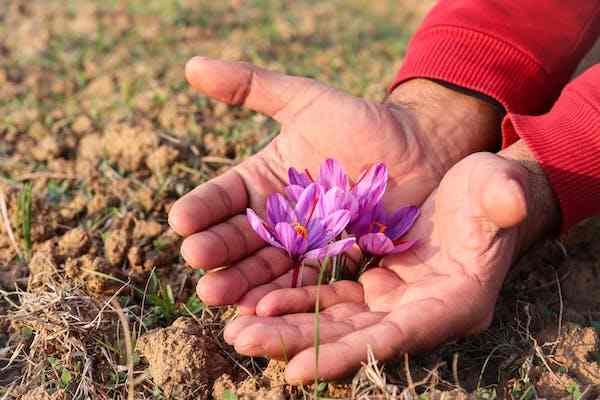# Why is Saffron Hard to Grow?
Saffron, often called “red gold,” is a valuable spice. It’s famous for its unique flavor and health benefits. But growing saffron is not easy. Many people wonder why. This article explains the challenges of saffron cultivation.
## Climate Requirements
Saffron thrives in specific climates. It needs a mix of hot, dry summers and cold winters. This combination is rare. Places like Iran, Spain, and India’s Kashmir region have the right conditions. Many other places do not.
### Hot, Dry Summers
Saffron bulbs, called corms, need hot, dry summers. This period is when they go dormant. The heat helps them store energy. Too much rain or humidity can cause the corms to rot.
### Cold Winters
Cold winters are also crucial. The corms need this chill to break dormancy. It signals them to start growing. Mild winters can disrupt this cycle.
## Soil Conditions
Saffron needs well-draining soil. It prefers sandy or loamy soil with good drainage. Heavy clay soils retain too much water. This can lead to root rot and fungal diseases.
### Soil pH
The soil pH should be between 6 and 8. Acidic or alkaline soils can hinder growth. Regular soil testing helps maintain the right pH levels.
### Nutrient-Rich Soil
Saffron corms need nutrients. Organic matter like compost or manure enriches the soil. Adding these helps the corms grow strong and healthy.
## Labor-Intensive Process
Saffron farming is labor-intensive. Each step requires careful attention. This includes planting, weeding, and harvesting.
### Planting
Planting saffron corms is time-consuming. Each corm must be planted by hand. They need to be placed 10-15 cm deep and spaced about 15 cm apart. This precise planting ensures good growth.
### Weeding
Weeding is crucial. Weeds compete for nutrients and water. Regular weeding helps saffron plants thrive. This task also needs to be done by hand, adding to the labor.
### Harvesting
Harvesting saffron is the most labor-intensive step. The flowers bloom in the fall. Each flower has three red stigmas. These stigmas are the saffron threads.
### Picking Flowers
Workers must pick the flowers early in the morning. This is when they are fully open. Each flower is picked by hand. It’s a delicate task to avoid damaging the flowers.
### Stigma Separation
After picking, the stigmas must be separated. Workers remove the three red threads from each flower. This step also requires precision and care.
### Drying
The threads then need to be dried. This process enhances their flavor and aroma. Traditional methods include drying them in the sun or using specialized drying equipment.
## Pests and Diseases
Pests and diseases pose significant challenges. They can damage or destroy saffron crops.
### Pests
Common pests include rodents and insects. Rodents can eat the corms, causing significant damage. Insects like thrips and aphids feed on the plants. They can transmit diseases and weaken the plants.
### Diseases
Fungal diseases are a major threat. Root rot and corm rot are common problems. These diseases thrive in wet conditions. Proper drainage and crop rotation help manage these issues.
## Limited Growing Season
Saffron has a limited growing season. The flowers bloom for just a few weeks in the fall. This short window requires precise timing for planting and harvesting.
### Timing
Planting too early or too late affects bloom. Farmers need to monitor the weather and soil conditions closely. Harvesting must also be timed perfectly to ensure the best quality saffron.
## High Initial Costs
Starting a saffron farm is expensive. The corms are costly. High-quality corms are essential for good yields. Farmers need to invest in irrigation systems and soil preparation. These initial costs can be a barrier for many.
### Corm Quality
Investing in high-quality corms is crucial. Poor quality corms result in poor yields. Farmers often source corms from reputable suppliers to ensure success.
### Irrigation Systems
Irrigation is vital in dry regions. Drip irrigation systems are often used. They provide consistent moisture without overwatering. This system is costly but essential for maintaining healthy plants.
## Market Fluctuations
Saffron prices fluctuate. Market demand and supply affect prices. This volatility can impact farmers’ incomes.
### Global Demand
Saffron is in high demand globally. It’s used in cooking, medicine, and cosmetics. However, supply shortages or overproduction can cause price changes.
### Economic Factors
Economic conditions also influence prices. Currency exchange rates, trade policies, and political stability in saffron-growing regions affect market prices.
## Environmental Impact
Saffron farming can impact the environment. Sustainable practices are important.
### Water Usage
Saffron requires careful water management. Overuse of water can deplete local resources. Efficient irrigation systems help conserve water.
### Soil Health
Maintaining soil health is crucial. Over-farming can deplete soil nutrients. Crop rotation and organic farming practices help maintain soil fertility.
## Conclusion
Growing saffron is a challenging endeavor. It requires specific climate conditions, well-draining soil, and a lot of manual labor. Pests and diseases, a short growing season, high initial costs, and market fluctuations add to the difficulty. Despite these challenges, saffron remains a prized spice. Its unique flavor, aroma, and health benefits make it worth the effort for many farmers. Sustainable farming practices and careful management can help overcome these challenges and ensure successful saffron cultivation.
By understanding these difficulties, we can appreciate the effort behind each thread of saffron. Next time you use saffron in your cooking, remember the hard work that went into growing it.


